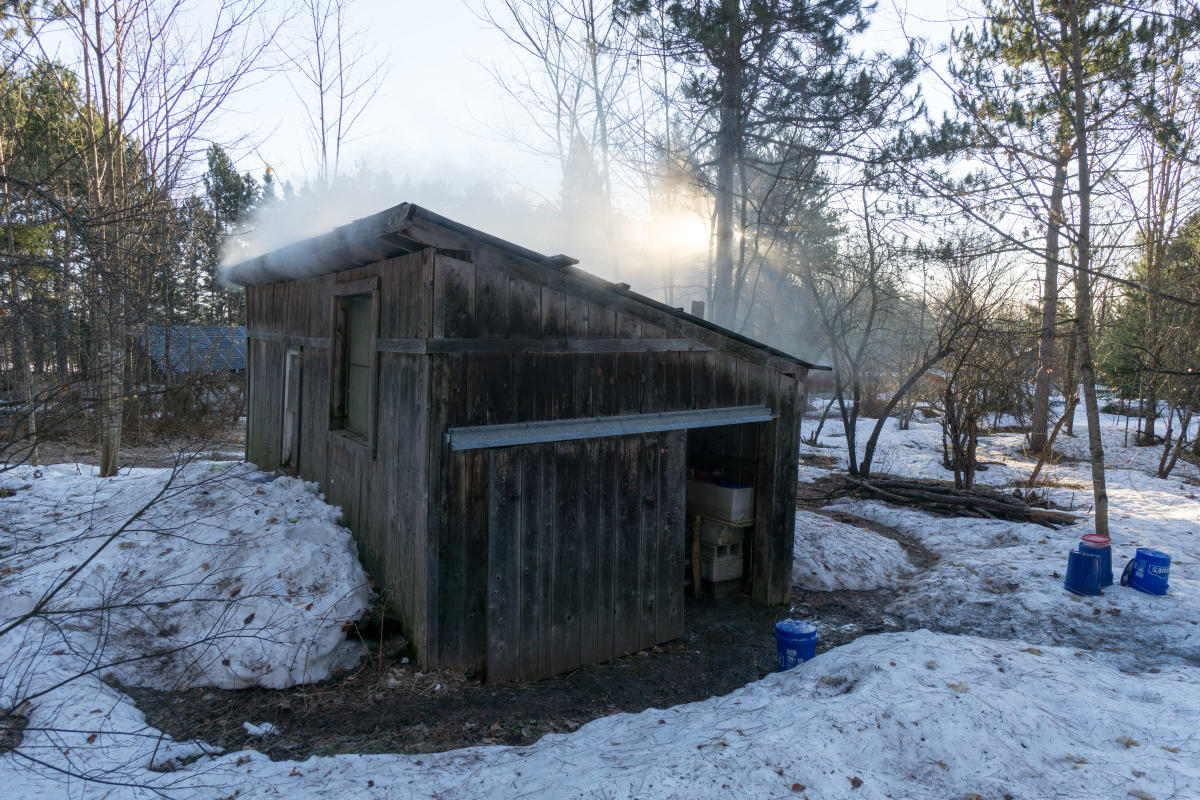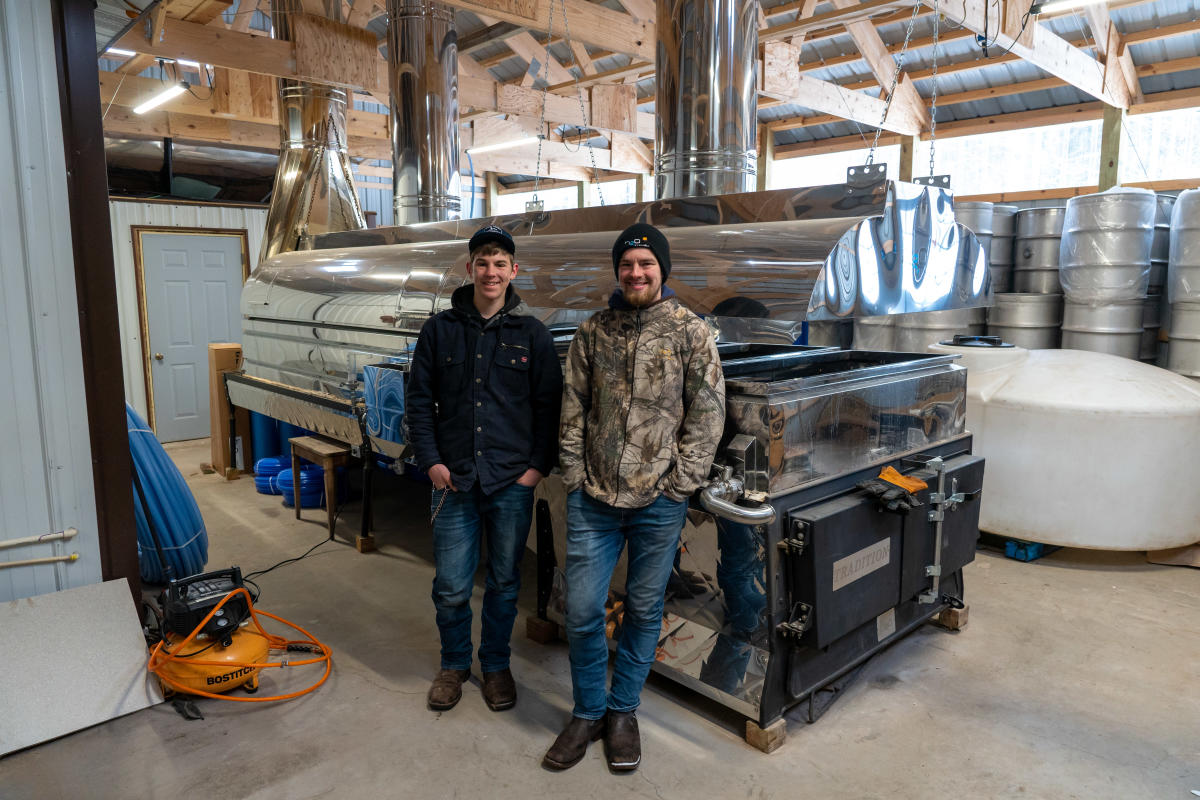The transition between the Keweenaw’s long winters and beautiful summers is often called mud season, and for good reason. All that snow has to go somewhere! While we wait for warmer weather to return, many Yoopers spend their time boiling. No, not in the sauna (okay, we still do that). Maple syrup boiling!
Making maple syrup is a time-honored tradition for people across the northwoods of the U.S. and Canada. The Keweenaw has its fair share of maple syrup producers both big and small. How do we do it? Read on to learn how your favorite breakfast treat is made and where you can find it during your next trip to the Copper Country.
What is it?
Contrary to popular belief, the goopy ‘pancake syrup’ you find in most stores is not maple syrup. If it doesn’t say Pure Maple Syrup on the label, it’s not the real thing! Pancake syrup is just corn syrup with artificial flavors. It’s cheaper and nowhere near as tasty as real maple syrup. Buyer beware.
Maple syrup is produced from the sap of maple trees (ya don’t say!). Sugar maples are typically the best source of this sugary fluid (again, stating the obvious here). However, red maples also can produce well. Both types are found in abundance in the Keweenaw. Maple syrup is basically concentrated maple sap, which itself is about 2% sugar. To earn the title of maple syrup, it must be precisely 66.7% sugar. A general rule of thumb is that it takes around forty gallons of sap to make one gallon of syrup. Getting it to that point takes a lot of work and is a big reason why pure maple syrup carries a price premium over the fake stuff.

Maple sap can only be collected during spring sap flows, or ‘runs’ in maple parlance. During the winter trees are dormant, but as temperatures rise above freezing during spring days the sap slowly is drawn from the roots back into the treetops, fueling leaf growth. Temperatures must swing above and below freezing for the sap to be drawn up effectively, usually during a 4-6 week window each spring. This is a busy time for maple syrup producers because that’s the only time we can create this liquid gold!
The Process (For Hobbyists)
For amateur producers like myself, making maple syrup is a great way to spend the spring as the snow melts. I make between 5-10 gallons a year, enough for myself, friends and family, and a batch or two of maple wine. To get the sap out of the tree, you have to drill a hole and ‘tap’ it with narrow spiles. These spiles allow the sap to run out of the tree into buckets. The larger the tree, the more taps it can support. Even though I use forty taps, these are concentrated on just twenty trees. Some of the biggest support three taps, each of which is capable of producing 1-3 gallons of sap on a good day!

When it comes to concentrating the sap into syrup, I boil it on a small evaporator in my sugar shack. An evaporator can be as simple as a few steam trays on a concrete block firebox, or as complicated as a truck-size contraption that professionals use (see below). Mine is 2’x3’ and fairly compact, the perfect size for my operation. It’s basically a wood stove with the top chopped off and replaced by a thin stainless steel pan. Add the sap, stoke the fire, watch the steam rise, and repeat… For several hours straight. Let me tell ya, it smells delicious and is great for the skin.

After many hours of adding sap and boiling off the excess water, the liquid has reached near-syrup levels of sugar. I carefully draw off my bounty and bring it back to the house to finish the last little bit. I’ve got an eye for how the boiling bubbles change as it hits the precise 66.7% concentration and can nail it almost every time. Then it’s a matter of filtering and bottling the syrup and the process is complete!
The Process (For Professionals)
Making maple syrup on a small scale is fine if you’re in it for fun. If you’re in it to make a living, the process is similar but much bigger. Niemela Family Growers outside of Chassell is one of the Keweweenaw’s biggest producers with an impressive array of equipment that puts my simple setup to shame. They use well over 9,000 taps across two entire forests! There’s no way they could check that many buckets each day, so each tap is connected to a series of plastic tubes suspended in the trees, all angled downhill. A central collection point literally sucks the sap out of the trees under a vacuum before transferring it to a 3,000 gallon sap tank in the sugar shack.
Prior to boiling, Niemela’s sends their sap through a reverse osmosis process which concentrates the sap to nearly 10% sugar. That might not sound like a lot, but to get from 2% to 10% over three-quarters of the water has been removed! That’s a TON less time they have to spend boiling on the evaporator before they reach syrup levels.

Speaking of which, their evaporator is HUGE! Their evaporator is 16’ x 5’ and has more chrome than a hot rod convention. It’s capable of boiling off an incredible 230 GALLONS of sap per hour and burns between 25-30 cords of wood each season. When the boil is really going, they’re firing it with a wheelbarrow of wood every 10-15 minutes. Concentrated sap is pumped in at one end and syrup comes out the other end more or less continuously for several hours. Then it’s filtered and stored in steel barrels for bottling during the slower parts of the year.
Their yearly maple syrup production? In an average season, 1,500 gallons. If we get a good year with several strong runs, that could be even higher!
The Syrup
No matter how you make it, maple syrup is a treasure. Significant amounts of time and energy go into its creation which makes every drop precious. Once you open a container of maple syrup, you’ll want to keep it refrigerated to keep it fresh. I warm mine up before pouring it on french toast or pancakes, although I know people who prefer it cold on their food too.
One final word from the experts: the darker your syrup, the stronger the flavor. Amber syrups are lighter in flavor and usually come from earlier sap runs. Later in the season more natural impurities from the sap are concentrated in the syrup, enhancing the flavor and making for an even more delicious treat. The length of the boil and temperature that the sap is stored before boiling also influence the color and flavor. Be on the lookout for “Grade A: Dark” or similar labeling when you shop for your maple syrup because that’s secretly the best kind!

Where To Get It
The Niemela Family Growers sugar bush sells maple syrup at their farm stands throughout the year both at their Chassell location and at farmers markets. If you happen to be in the Keweenaw during boiling season (typically mid-March to mid-April), their sugar shack on Tapiola Road outside of Chassell is open for tours every day except Sunday. Be sure to call ahead (906-523-4362) to make sure they’re boiling before you stop by, as maple season is weather dependent. This is a great opportunity to see for yourself how the good stuff gets made and maybe get a taste as fresh as it comes! Their maple syrup prices are affordable and come in a wide range of sizes. Pick some up on your next visit to the Keweenaw!
